Xiachong Feng
Adaptive Backtracking for Privacy Protection in Large Language Models
Aug 08, 2025Abstract:The preservation of privacy has emerged as a critical topic in the era of artificial intelligence. However, current work focuses on user-oriented privacy, overlooking severe enterprise data leakage risks exacerbated by the Retrieval-Augmented Generation paradigm. To address this gap, our paper introduces a novel objective: enterprise-oriented privacy concerns. Achieving this objective requires overcoming two fundamental challenges: existing methods such as data sanitization severely degrade model performance, and the field lacks public datasets for evaluation. We address these challenges with several solutions. (1) To prevent performance degradation, we propose ABack, a training-free mechanism that leverages a Hidden State Model to pinpoint the origin of a leakage intention and rewrite the output safely. (2) To solve the lack of datasets, we construct PriGenQA, a new benchmark for enterprise privacy scenarios in healthcare and finance. To ensure a rigorous evaluation, we move beyond simple static attacks by developing a powerful adaptive attacker with Group Relative Policy Optimization. Experiments show that against this superior adversary, ABack improves the overall privacy utility score by up to 15\% over strong baselines, avoiding the performance trade-offs of prior methods.
ScienceBoard: Evaluating Multimodal Autonomous Agents in Realistic Scientific Workflows
May 26, 2025



Abstract:Large Language Models (LLMs) have extended their impact beyond Natural Language Processing, substantially fostering the development of interdisciplinary research. Recently, various LLM-based agents have been developed to assist scientific discovery progress across multiple aspects and domains. Among these, computer-using agents, capable of interacting with operating systems as humans do, are paving the way to automated scientific problem-solving and addressing routines in researchers' workflows. Recognizing the transformative potential of these agents, we introduce ScienceBoard, which encompasses two complementary contributions: (i) a realistic, multi-domain environment featuring dynamic and visually rich scientific workflows with integrated professional software, where agents can autonomously interact via different interfaces to accelerate complex research tasks and experiments; and (ii) a challenging benchmark of 169 high-quality, rigorously validated real-world tasks curated by humans, spanning scientific-discovery workflows in domains such as biochemistry, astronomy, and geoinformatics. Extensive evaluations of agents with state-of-the-art backbones (e.g., GPT-4o, Claude 3.7, UI-TARS) show that, despite some promising results, they still fall short of reliably assisting scientists in complex workflows, achieving only a 15% overall success rate. In-depth analysis further provides valuable insights for addressing current agent limitations and more effective design principles, paving the way to build more capable agents for scientific discovery. Our code, environment, and benchmark are at https://qiushisun.github.io/ScienceBoard-Home/.
From Hypothesis to Publication: A Comprehensive Survey of AI-Driven Research Support Systems
Mar 03, 2025Abstract:Research is a fundamental process driving the advancement of human civilization, yet it demands substantial time and effort from researchers. In recent years, the rapid development of artificial intelligence (AI) technologies has inspired researchers to explore how AI can accelerate and enhance research. To monitor relevant advancements, this paper presents a systematic review of the progress in this domain. Specifically, we organize the relevant studies into three main categories: hypothesis formulation, hypothesis validation, and manuscript publication. Hypothesis formulation involves knowledge synthesis and hypothesis generation. Hypothesis validation includes the verification of scientific claims, theorem proving, and experiment validation. Manuscript publication encompasses manuscript writing and the peer review process. Furthermore, we identify and discuss the current challenges faced in these areas, as well as potential future directions for research. Finally, we also offer a comprehensive overview of existing benchmarks and tools across various domains that support the integration of AI into the research process. We hope this paper serves as an introduction for beginners and fosters future research. Resources have been made publicly available at https://github.com/zkzhou126/AI-for-Research.
Reasoning Does Not Necessarily Improve Role-Playing Ability
Feb 24, 2025Abstract:The application of role-playing large language models (LLMs) is rapidly expanding in both academic and commercial domains, driving an increasing demand for high-precision role-playing models. Simultaneously, the rapid advancement of reasoning techniques has continuously pushed the performance boundaries of LLMs. This intersection of practical role-playing demands and evolving reasoning capabilities raises an important research question: "Can reasoning techniques enhance the role-playing capabilities of LLMs?" To address this, we conduct a comprehensive study using 6 role-playing benchmarks, 24 LLMs, and 3 distinct role-playing strategies, comparing the effectiveness of direct zero-shot role-playing, role-playing with Chain-of-Thought (CoT), and role-playing using reasoning-optimized LLMs. Our findings reveal that CoT may reduce role-playing performance, reasoning-optimized LLMs are unsuitable for role-playing, reasoning ability disrupts the role-playing scaling law, large models still lack proficiency in advanced role-playing, and Chinese role-playing performance surpasses English role-playing performance. Furthermore, based on extensive experimental results, we propose two promising future research directions: Role-aware CoT for improving role-playing LLMs and Reinforcement Learning for role-playing LLMs, aiming to enhance the adaptability, consistency, and effectiveness of role-playing LLMs for both research and real-world applications.
Sailor2: Sailing in South-East Asia with Inclusive Multilingual LLMs
Feb 18, 2025
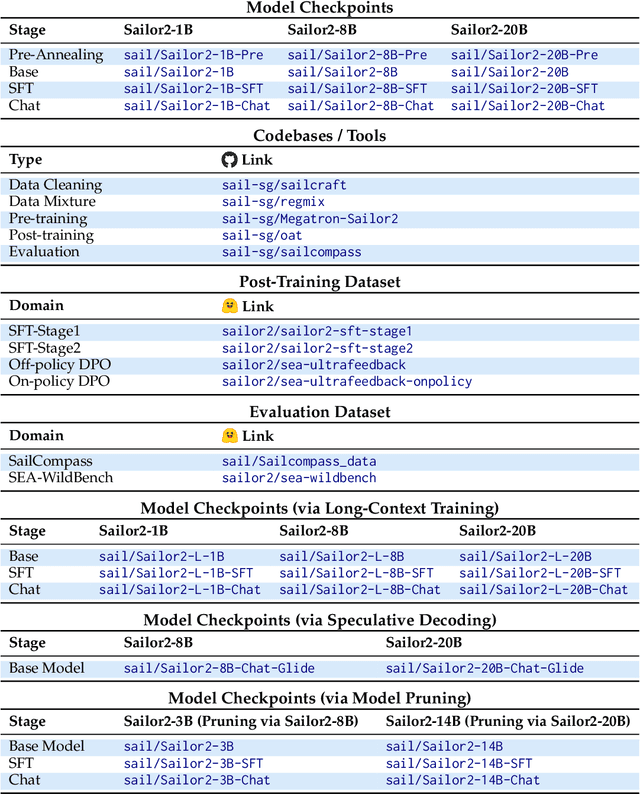
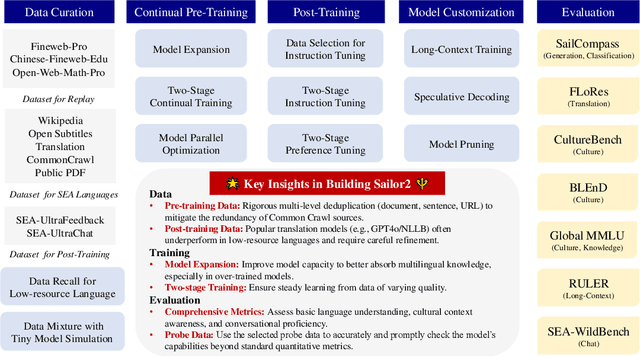
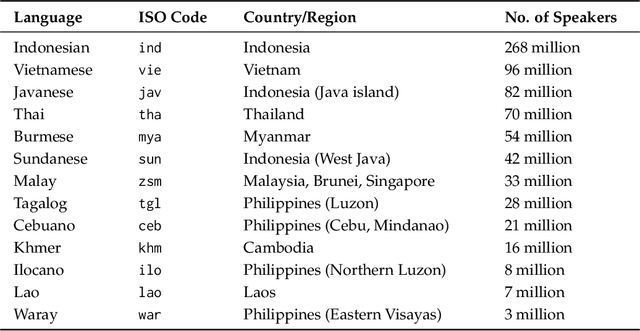
Abstract:Sailor2 is a family of cutting-edge multilingual language models for South-East Asian (SEA) languages, available in 1B, 8B, and 20B sizes to suit diverse applications. Building on Qwen2.5, Sailor2 undergoes continuous pre-training on 500B tokens (400B SEA-specific and 100B replay tokens) to support 13 SEA languages while retaining proficiency in Chinese and English. Sailor2-20B model achieves a 50-50 win rate against GPT-4o across SEA languages. We also deliver a comprehensive cookbook on how to develop the multilingual model in an efficient manner, including five key aspects: data curation, pre-training, post-training, model customization and evaluation. We hope that Sailor2 model (Apache 2.0 license) will drive language development in the SEA region, and Sailor2 cookbook will inspire researchers to build more inclusive LLMs for other under-served languages.
Cross-Lingual Text-Rich Visual Comprehension: An Information Theory Perspective
Dec 23, 2024



Abstract:Recent Large Vision-Language Models (LVLMs) have shown promising reasoning capabilities on text-rich images from charts, tables, and documents. However, the abundant text within such images may increase the model's sensitivity to language. This raises the need to evaluate LVLM performance on cross-lingual text-rich visual inputs, where the language in the image differs from the language of the instructions. To address this, we introduce XT-VQA (Cross-Lingual Text-Rich Visual Question Answering), a benchmark designed to assess how LVLMs handle language inconsistency between image text and questions. XT-VQA integrates five existing text-rich VQA datasets and a newly collected dataset, XPaperQA, covering diverse scenarios that require faithful recognition and comprehension of visual information despite language inconsistency. Our evaluation of prominent LVLMs on XT-VQA reveals a significant drop in performance for cross-lingual scenarios, even for models with multilingual capabilities. A mutual information analysis suggests that this performance gap stems from cross-lingual questions failing to adequately activate relevant visual information. To mitigate this issue, we propose MVCL-MI (Maximization of Vision-Language Cross-Lingual Mutual Information), where a visual-text cross-lingual alignment is built by maximizing mutual information between the model's outputs and visual information. This is achieved by distilling knowledge from monolingual to cross-lingual settings through KL divergence minimization, where monolingual output logits serve as a teacher. Experimental results on the XT-VQA demonstrate that MVCL-MI effectively reduces the visual-text cross-lingual performance disparity while preserving the inherent capabilities of LVLMs, shedding new light on the potential practice for improving LVLMs. Codes are available at: https://github.com/Stardust-y/XTVQA.git
XTransplant: A Probe into the Upper Bound Performance of Multilingual Capability and Culture Adaptability in LLMs via Mutual Cross-lingual Feed-forward Transplantation
Dec 17, 2024Abstract:Current large language models (LLMs) often exhibit imbalances in multilingual capabilities and cultural adaptability, largely due to their English-centric pretraining data. To address this imbalance, we propose a probing method named XTransplant that explores cross-lingual latent interactions via cross-lingual feed-forward transplantation during inference stage, with the hope of enabling the model to leverage the strengths of both English and non-English languages. Through extensive pilot experiments, we empirically prove that both the multilingual capabilities and cultural adaptability of LLMs hold the potential to be significantly improved by XTransplant, respectively from En -> non-En and non-En -> En, highlighting the underutilization of current LLMs' multilingual potential. And the patterns observed in these pilot experiments further motivate an offline scaling inference strategy, which demonstrates consistent performance improvements in multilingual and culture-aware tasks, sometimes even surpassing multilingual supervised fine-tuning. And we do hope our further analysis and discussion could help gain deeper insights into XTransplant mechanism.
A Survey on Large Language Model-Based Social Agents in Game-Theoretic Scenarios
Dec 05, 2024



Abstract:Game-theoretic scenarios have become pivotal in evaluating the social intelligence of Large Language Model (LLM)-based social agents. While numerous studies have explored these agents in such settings, there is a lack of a comprehensive survey summarizing the current progress. To address this gap, we systematically review existing research on LLM-based social agents within game-theoretic scenarios. Our survey organizes the findings into three core components: Game Framework, Social Agent, and Evaluation Protocol. The game framework encompasses diverse game scenarios, ranging from choice-focusing to communication-focusing games. The social agent part explores agents' preferences, beliefs, and reasoning abilities. The evaluation protocol covers both game-agnostic and game-specific metrics for assessing agent performance. By reflecting on the current research and identifying future research directions, this survey provides insights to advance the development and evaluation of social agents in game-theoretic scenarios.
Understanding the Role of LLMs in Multimodal Evaluation Benchmarks
Oct 16, 2024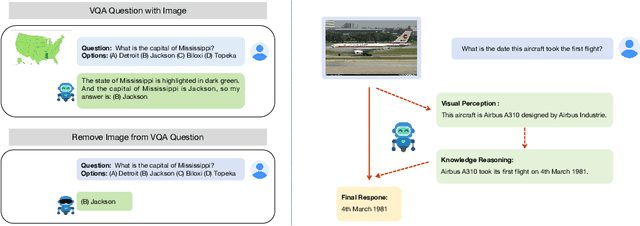
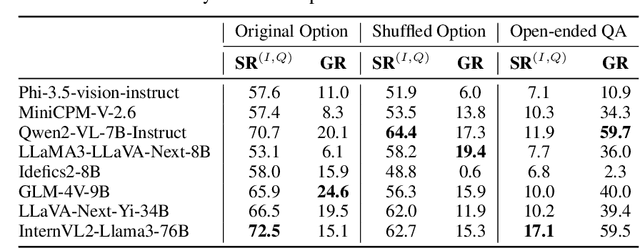
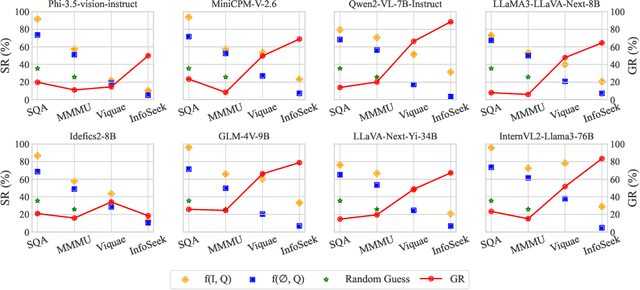

Abstract:The rapid advancement of Multimodal Large Language Models (MLLMs) has been accompanied by the development of various benchmarks to evaluate their capabilities. However, the true nature of these evaluations and the extent to which they assess multimodal reasoning versus merely leveraging the underlying Large Language Model (LLM) backbone remain unclear. This paper presents a comprehensive investigation into the role of LLM backbones in MLLM evaluation, focusing on two critical aspects: the degree to which current benchmarks truly assess multimodal reasoning and the influence of LLM prior knowledge on performance. Specifically, we introduce a modified evaluation protocol to disentangle the contributions of the LLM backbone from multimodal integration, and an automatic knowledge identification technique for diagnosing whether LLMs equip the necessary knowledge for corresponding multimodal questions. Our study encompasses four diverse MLLM benchmarks and eight state-of-the-art MLLMs. Key findings reveal that some benchmarks allow high performance even without visual inputs and up to 50\% of error rates can be attributed to insufficient world knowledge in the LLM backbone, indicating a heavy reliance on language capabilities. To address knowledge deficiencies, we propose a knowledge augmentation pipeline that achieves significant performance gains, with improvements of up to 60\% on certain datasets, resulting in a approximately 4x increase in performance. Our work provides crucial insights into the role of the LLM backbone in MLLMs, and highlights the need for more nuanced benchmarking approaches.
TMGBench: A Systematic Game Benchmark for Evaluating Strategic Reasoning Abilities of LLMs
Oct 14, 2024



Abstract:The rapid advancement of large language models (LLMs) has accelerated their application in reasoning, with strategic reasoning drawing increasing attention. To evaluate LLMs' strategic reasoning capabilities, game theory, with its concise structure, has become a preferred approach. However, current research focuses on a limited selection of games, resulting in low coverage. Classic game scenarios risk data leakage, and existing benchmarks often lack extensibility, making them inadequate for evaluating state-of-the-art models. To address these challenges, we propose TMGBench, a benchmark with comprehensive game type coverage, novel scenarios, and flexible organization. Specifically, we incorporate all 144 game types summarized by the Robinson-Goforth topology of 2x2 games, constructed as classic games. We also employ synthetic data generation to create diverse, higher-quality scenarios through topic guidance and human inspection, referred to as story-based games. Lastly, we provide a sustainable framework for increasingly powerful LLMs by treating these games as atomic units and organizing them into more complex forms via sequential, parallel, and nested structures. Our comprehensive evaluation of mainstream LLMs covers tests on rational reasoning, robustness, Theory-of-Mind (ToM), and reasoning in complex forms. Results reveal flaws in accuracy, consistency, and varying mastery of ToM. Additionally, o1-mini, OpenAI's latest reasoning model, achieved accuracy rates of 66.6%, 60.0%, and 70.0% on sequential, parallel, and nested games, highlighting TMGBench's challenges.
 Add to Chrome
Add to Chrome Add to Firefox
Add to Firefox Add to Edge
Add to Edge